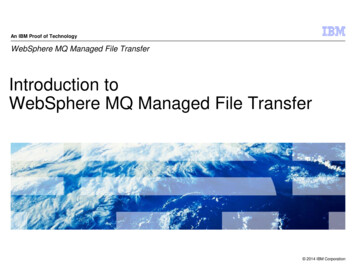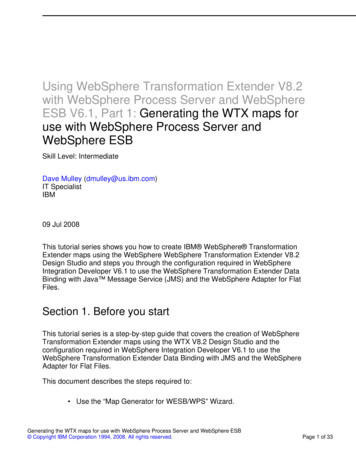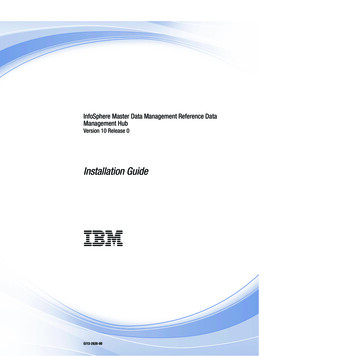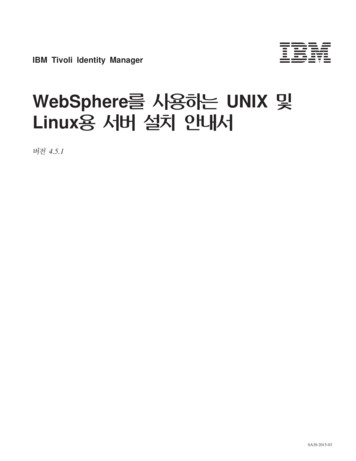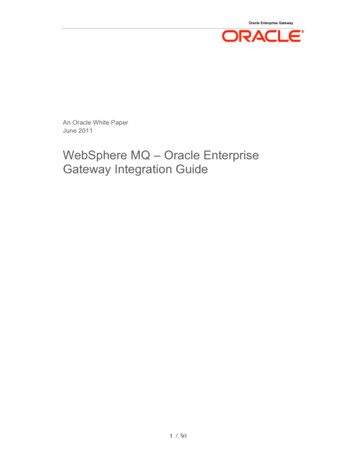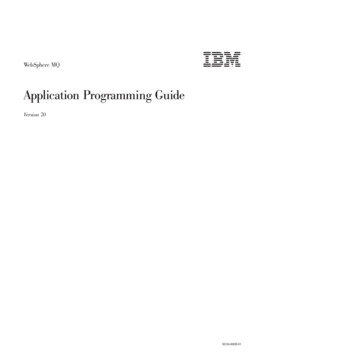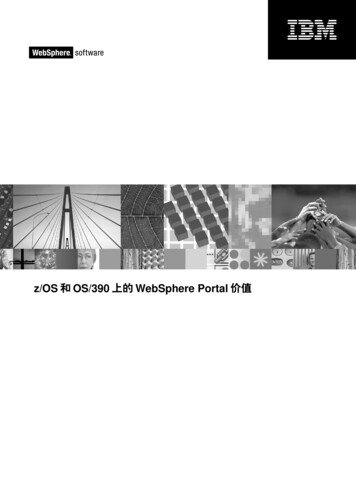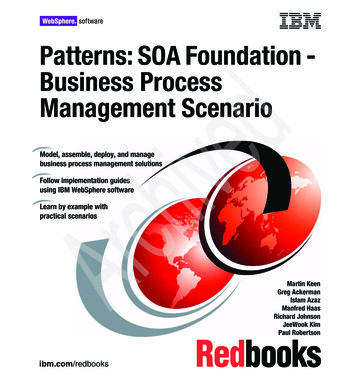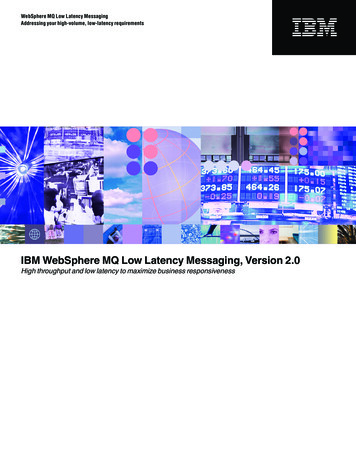
Transcription
WebSphere MQ Low Latency MessagingAddressing your high-volume, low-latency requirementsIBM WebSphere MQ Low Latency Messaging, Version 2.0High throughput and low latency to maximize business responsiveness
IBM WebSphere MQ Low Latency Messaging is a messaging transport that is highly optimized for the veryhigh-volume, low-latency requirements of financial services firms. Applications include the high-speed delivery ofmarket data, trade data, reference data and event data in or between front-, middle- and back-office operations.Characteristic applications require extremely low (submillisecond) latency and high message volumes (ranging frommany thousands to millions of messages per second).
“In financial markets, microsecondscan make the difference. We arepleased to be working with IBM tooffer significantly higher throughputand significantly lower latency asproven by our performance tests.”— Patrick Guay,Senior Vice President of Marketing,VoltaireWebSphere MQ Low Latency Messaging, Version 2.0 extendsHigh-speed messagingthe WebSphere MQ product line with a new transportWebSphere MQ Low Latency Messaging offers thedesigned for low-latency, high-throughput messaging. Itmessaging technology previously available as a componentadds to the existing range of transports a messaging productof WebSphere Front Office for Financial Markets as anoptimized for the very high-volume, low-latency requirementsenhanced, separately available product. Its messaging QoStypical of financial services firms and other industries wherecan be used as a stand-alone element of financial marketsspeed of data delivery is paramount. Although WebSpheresolutions or in other industries that have similar needsMQ continues to provide the premier solution for rock-solid,for reliable, high-speed data delivery. WebSphere MQ Lowassured, time-independent message delivery, the addition ofLatency Messaging is also embedded in WebSphereWebSphere MQ Low Latency Messaging to the WebSphereFront Office.messaging portfolio augments this comprehensive suite oftransport protocols to address an increasingly broad rangeBased on technology developed at the IBM Haifa Researchof quality of service (QoS) requirements.Lab, WebSphere MQ Low Latency Messaging achieves itsbreakthrough speed by packetizing data efficiently andIBM WebSphere MQ Low Latency Messaging delivers:exploiting Internet Protocol (IP) multicast infrastructure in adaemonless fashion to eliminate network connections. Very high messaging throughput with low latencyWebSphere MQ Low Latency Messaging provides a multicast One-to-many multicast messagingtransport for high-speed, one-to-many communications using Point-to-point unicast messagingUDP with receiver feedback. Although typical multicast Support for Support for User Datagram Protocol (UDP)implementations offer only best-effort, unreliable messageand Transmission Control Protocol (TCP)delivery, the addition of delivery options for receiver feedback Positive or negative message acknowledgementenables business-based tradeoffs of speed over reliability or Stream failover for high availabilityreliability over speed. Flexible, fine-grained message filtering Traffic rate and congestion control Robust monitoring of application and network statistics,including internal and external latency Support for Linux, Windows and Solaris platforms
WebSphere MQ Low Latency Messaging offers two transportsWebSphere MQ Low Latency Messaging supports highlyin addition to reliable multicast. The first alternative is aavailable message transmission. All transports enablelightweight, point-to-point UDP transport with either positive-high- availability distribution by implementing a number ofor negative-feedback reliability and traffic control featuresstream failover policies that allow seamless migration ofsimilar to the multicast offering. With positive acknowledgment,message transmission from failed to backup processes.all packets are acknowledged, whereas negativeThe unicast transport enables connection retry and resendacknowledgment provides feedback only if a packet is lost.as necessary, and heartbeat signals to verify that theThe second alternative offers reliable, point-to-point, unicastconnection is kept alive.messaging over TCP/IP, in which reliability and traffic controlare primarily handled by the TCP protocol. These alternativesWebSphere MQ Low Latency Messaging also offers aprovide the ability to deliver a stream of data across a widerange of message-filtering options, including coarse-grained,area network (WAN) or through a firewall.topic-based and fine-grained filtering. This flexibility allows theapplication to control the amount of data that is delivered toStandard multicast transports do not offer congestion-controleach application to make the most efficient use of networkor failover capabilities, resulting in competition betweenbandwidth and processing resources.receivers and between streams with subsequent delaysand data loss. WebSphere MQ Low Latency Messaging addsInfiniBand is a next-generation interconnect standard thattraffic-control features on top of the multicast layer for bothoffers high transmission rates and scalability. WebSphere MQmulticast and unicast transports. Both multicast and unicastLow Latency Messaging delivers support for InfiniBand overtransports include methods to monitor traffic (includingIP to enable higher throughput with even lower latency,transmission rate, losses and retransmissions, and latency) toreduced latency variability and low central processing unitnotify the application of network-congestion problems and to(CPU) consumptionmanage these detected problems by handling slow receiversor regulating the transmission rate.“The performance and interoperability of WebSphere MQ Low Latency Messaging will giveour clients even more open access to Reuters systems at greater speed than ever. For thefirst time, developers will be able to build new applications using IBM messaging software toaccess content from [Reuters Market Data System] RMDS and to distribute it into other partsof their organizations. This is another example of our key aim to put customers first, and welook forward to working more closely with IBM as it introduces further enhancements to thesuite of IBM WebSphere Software products.”—Peter Moss,Global Head of Enterprise Solutions,Reuters
Dataaggregatorsand s, pricing,trade and ordermanagementPre- and posttrade complianceCounterpartyconfirmationsWebSphere MQ Low Latency MessagingInternal andreference dataPositions nsPaymentsWebSphere MQMarket and creditrisk analyticsFront officeAccounting andgeneral ledgerPositions andportfoliosMiddle officeBack officeInternalFigure 1. Low-latency messaging and WebSphere MQ in the trade processApplications of WebSphere MQ Low Latency MessagingWebSphere MQ Low Latency Messaging can help addressWith the rapid growth of algorithmic and model-driven tradingthese common issues:and direct market access, financial services firms requiresuperior messaging infrastructures to manage the massive·Increasing market-data volumes: Fragmented orders and higherexplosion of data to remain competitive. “Firms are turning tomessage traffic due to growth in electronic exchanges, high-electronic trading, in part because a 1-millisecond advantagefrequency trading strategies and longer trading hoursin trading applications can be worth millions of dollars a year·to a major brokerage firm.”1high volume and throughput requirements·As shown in Figure 1, WebSphere MQ Low Latencyfor example REG NMS and MiFID·of the following types of information:Excessive message latency: Caused when daemon-basedmessaging solutions insert excessive network connections· Market data from exchanges to market-data consumersIncreasing regulatory requirements: Determination required ofbest price for all client orders, with execution against that price,Messaging can be used almost anywhere within themarket-data and trading life cycle. This can include deliveryPressure on existing messaging solutions: Inability to handleDropped messages and network storms: When high volumes ofmessages interfere with one another Market and reference data within the enterprise to analytic ortrading applications Trade data — such as positions, orders and confirmations — todirect market access and other trading applications Event notifications for systems monitoring, risk analytics andcompliance applicationsWebSphere MQ Low Latency Messaging can extend theadvantages already available within WebSphere Front Officefor the transport of market data to a broad range of messagesfor the middle and back offices of financial markets, andto other industries with similar needs. Potential futureapplications of WebSphere MQ Low Latency Messagingcould include transportation, chemical and petroleum processing defense, multimedia and other industries that requirehigh-volume, low-latency, reliable message delivery.
Performance tests conducted in IBM’s Haifa ResearchThe following results were achieved:Lab demonstrate the outstanding performance and latencythat can be achieved with WebSphere MQ Low Latency About one million 120-byte messages per second on EthernetMessaging.2 The test environment included these components: Close to three million 120-byte messages per second onInfiniBand Two IBM BladeCenter HS21 servers with two Intel Xeon More than 8 million smaller messages per second, all on common 5130 2 GHz CPUs and 4 GB RAM running Linux RH4 Update 4x86 servers on Ethernet Very low latency of 30 microseconds for 120-byte messages(x86-64, 64-bit instruction set) Gigabit Ethernet network, including one Cisco switch for IBMBladeCenter H and two internal IBM BladeCenter GigabitEthernet expansion cards Voltaire InfiniBand network, including one Voltaire ISR9096 switch, Version 4.0.0; two InfiniBand x4 HCA cards(PCI-Express x8); three Voltaire GridStack, Version 4.3.0 4 e2;and four InfiniBand multicast libraries by Voltaire, called MCE,Version 207ThroughputNetworkMessage size [bytes]InfiniBand (MCE)Ethernet (1 Gbps)msgs/secMbpsmsgs/secMbps128 250 0007748 360 000784457 080 00024902 500 0008881202 900 0002730970 0009121200270 000254099 00092812 00026 00024309850923120 00029402750987926Table 1. Throughput3Gbps gigabits per secondMbps megabits per secondSingle-hop latency (microseconds)NetworkInfiniBand (MCE)Ethernet (1 Gbps)Messagesize 971961206193171100080253Table 2. Average single-hop latency Transmission rate (msgs/sec)147
New messaging quality of serviceWebSphere MQ Low Latency Messaging is designed toprovide the qualities of service that financial services need,as shown in Table 3.WebSphere MQ familyIBM WebSphere MQ products serve as the backbone formessaging throughout the entire enterprise, both internallyand externally. The comprehensive suite of transport protocoland QoS options combined with extensive support andindividual computing platforms and runtime environmentsprovide the underpinning for an enterprise service bus (ESB)architecture and speedy adoption of a service orientedarchitecture (SOA).For more informationTo learn more about how IBM WebSphere MQ Low LatencyMessaging, Version 2.0 can help you optimize yourinvestments and reach your business and IT goals, contactyour IBM representative or IBM Business Partner, or e MQWebSphere MQ Low Latency MessagingSpeed QoSTime-independent, “as-soon-as-possible” deliveryUltra-fast delivery in microsecondsReliability QoSUltra-reliable, “bet the business” deliveryReliable, “know-when-you-lose-data” deliveryTarget marketEnterprise messagingLow-latency messagingTarget industriesAllFinancial markets and others with similarQoS needsQueuingYesNoAPIsJMS, XMS and MQIUnique, including its own set of APIs optimizedfor low-latency message deliveryPlatform coverage80 platformsLinux and Microsoft Windows on x86Table 3. Comparison of IBM messaging transports
IBM WebSphere MQ Low Latency Messaging, Version 2.0 at a glanceHardware requirements Copyright IBM Corporation 2007 Processor: AMD or Intel x86 architecture 32- or 64-bit, or Solaris UltraSPARCIBM CorporationSoftware GroupRoute 100Somers, NY 10589U.S.A. One processor with a minimum processor speed of 2.0 GHz(dual processor or dual core recommended) Minimum memory requirements: 1 GBPrinted in the U.S.A.11-07All Rights Reserved.Software requirementsOne of the following operating system platforms:IBM, the IBM logo, BladeCenter, CICS, DB2,DataPower, IMS and WebSphere are trademarks ofthe International Business Machines Corporation inthe United States, other countries or both. Red Hat Enterprise Linux AS/WS 4 Update 5 (x86 or x86-64) Red Hat Enterprise Linux 5 Server or Client (x86 or x86-64) SUSE Enterprise Linux 10 SP1 Server or Desktop (x86 or x86-64)Intel and Intel Xeon are trademarks of IntelCorporation or its subsidiaries in the United Statesand other countries. Microsoft Windows XP SP2 (x86 or x86-64) Microsoft Windows Server 2003 SP1 (x86 or 86-64)Java and all Java-based trademarks are trademarksof Sun Microsystems, Inc. in the United States, othercountries or both. Microsoft Windows Vista (x86 or x86-64) Solaris 10 UltraSPARC (32- or 64-bit) Solaris 10 (x86 or x86-64)Linux is a registered trademark of Linus Torvalds inthe United States, other countries, or both.Development systems requirementsMicrosoft and Windows are trademarks of MicrosoftCorporation in the United States,other countries or both.One of the following compilers: Linux libraries compiled with gcc 4.1.1Other company, product and service names may betrademarks or service marks of others. Windows libraries compiled with Microsoft Visual Studio 8.0References in this publication to IBM products orservices do not imply that IBM intends to makethem available in all countries in which IBM operates. Solaris libraries compiled with Sun Studio 11Performance considerationsWebSphere MQ Low Latency Messaging performance depends on the complexity of the specificenvironment, volume of data traffic and the data object size.1Martin, Richard. 2007. “Data Latency Playing AnEver Increasing Role In Effective Trading.” Attributedto Information Week by Wall Street & cecenters/low-latency/showArticle.jhtml?articleID 199702208(accessed October 25, 2007).2The performance numbers listed for WebSphereMQ Low Latency Messaging are based on measurements using standard IBM benchmarks in acontrolled environment. The actual throughput thatany application will experience may vary depending upon considerations such as message size,transmission rate, hardware platform, and networkconfiguration. Therefore, no assurance can begiven that an individual application will achievethe throughput or latency stated here. Customersshould conduct their own testing. For more detailedperformance information, consult your IBM salesrepresentative.3Notes for Table 1: When using Ethernet, the throughput of reliable multicast messaging (RMM) is limited by the networkspeed, which is 1000 Mbps. Using a simple load driver shows that the throughput of the MCE library over Infiniband is 2750 Mbps.We can see that, except for the case of 12 bytesmessages, the throughput of RMM is almost thesame. That is, RMM is limited by the maximumthroughput of the MCE library. The reported throughput (in the Mbps column) isthat of the application. The throughput going out tothe network is actually higher due to RMM and network headers, which are appended to each packet.WSB14003-USEN-00
IBM WebSphere MQ Low Latency Messaging is a messaging transport that is highly optimized for the very high-volume, low-latency requirements of financial services firms. Applications include the high-speed delivery of market data, trade data, reference data and event data in or between front-, middle- and back-office operations.
